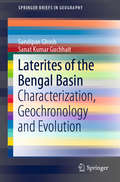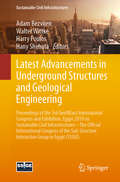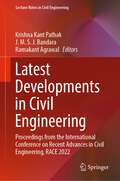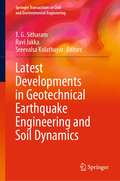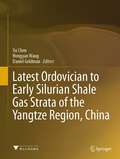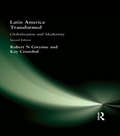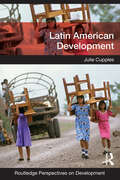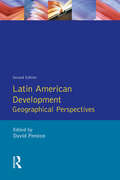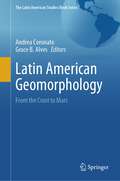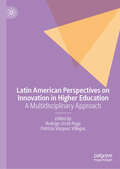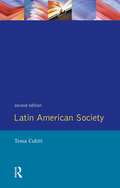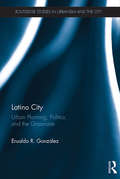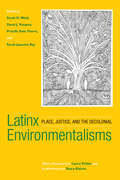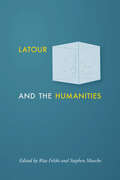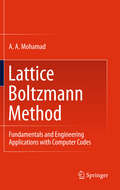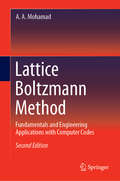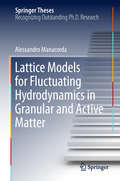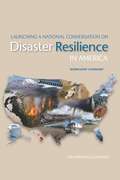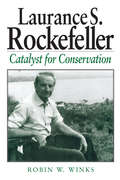- Table View
- List View
Late Tudor and Early Stuart Geography, 1583-1650: A Sequel to Tudor Geography, 1485-1583 (Routledge Revivals)
by E. G. TaylorFirst published in 1934, Late Tudor and Early Stuart Geography is a critical commentary on a chronologically arranged bibliography of nearly two thousand contemporary printed and manuscript works. Poets, preachers and philosophers, mathematicians, physicians and astrologers, sailors, merchants and company-promoters were contributors to the absorbing medley that comprises the geographical literature of the late Tudor and early Stuart period. For this was the fading twilight of that Golden Age of unspecialized learning when all knowledge lay within one man’s compass. This book will be of interest to historians, economists, sociologists and litterateurs.
Late- and Postglacial Oscillations of Glaciers: Glacial And Periglacial Forms
by H. Schroeder-LanzThis volume represents the proceedings from a colloquium held in West Germany in 1980 on late and postglacial oscillations of glaciers. The main texts are in German (13), English (8) and French (5) but all have abstracts in the three languages and all the figure captions are similarly translated.
Laterites of the Bengal Basin: Characterization, Geochronology and Evolution (SpringerBriefs in Geography)
by Sandipan Ghosh Sanat Kumar GuchhaitThis Brief analyses and discusses the laterites in the Bengal Basin. The book highlights: (1) the definition, identification and classification of ferruginous materials, (2) the mode of laterite formation and its other horizons, (3) processes and theories of lateritisation, (4) determination of laterite ages, (5) recognition of palaeogeomorphic and palaeoclimatic significance and (6) geo-chronology and reconstruction of former lateritized landscapes. The chapters cover the tectono-climatic evolution of north-south laterite profiles of the north-western Bengal Basin on the Rajmahal Basalt Traps, Archean Granite-Gneiss, Gondwana Sandstones, Palaeogene Gravels and Older Palaeo-Deltaic Alluvium. The book uses advanced field-based studies, quantitative analysis and thematic mapping to cover various areas of palaeogeography and regolith geology of the Bengal Basin in connection with laterite genesis, palaeoweathering, tectonic geomorphology, Quaternary geomorphology and pedogeomorphology. It introduces laterites as a potential stratigraphic marker in Indian geology by explaining their palaeogeomorphic and palaeoclimatic significance.This Brief is a comprehensive resource to researchers, students and academicians of geography, geomorphology and geology working on laterites.
Latest Advancements in Underground Structures and Geological Engineering: Proceedings of the 3rd GeoMEast International Congress and Exhibition, Egypt 2019 on Sustainable Civil Infrastructures – The Official International Congress of the Soil-Structure Interaction Group in Egypt (SSIGE) (Sustainable Civil Infrastructures)
by Walter Wittke Hany Shehata Harry Poulos Adam BezvijenThis book includes the best-selected papers on the latest advancements in underground structures and geological engineering.The ongoing population growth is resulting in rapid urbanization, new infrastructure development, and increasing demand for the Earth's natural resources (e.g., water, oil/gas, minerals). This, together with the current climate change and increasing impact of natural hazards, implies that the engineering geology profession is called upon to respond to new challenges. It is recognized that these challenges are particularly relevant in the developing and newly industrialized regions.
Latest Developments in Civil Engineering: Proceedings from the International Conference on Recent Advances in Civil Engineering, RACE 2022 (Lecture Notes in Civil Engineering #352)
by J. M. S. J. Bandara Ramakant Agrawal Krishna Kant PathakThis book comprises select proceedings of the International Conference on Recent Advances in Civil Engineering (RACE 2022). The contents of this book focus on the recent advancements and innovations in the field of civil engineering and various related areas such as design and development of new sustainable and smart building materials, performance analysis and simulation of steel structures, design and performance optimization of concrete structures, structural engineering, geotechnical engineering, water resources engineering and hydraulics, transportation and bridge engineering, building services design, surveying and remote sensing, engineering management and renewable energy. This book serves as a useful reference to researchers and professionals in the field of civil engineering.
Latest Developments in Geotechnical Earthquake Engineering and Soil Dynamics (Springer Transactions in Civil and Environmental Engineering)
by T. G. Sitharam Sreevalsa Kolathayar Ravi JakkaThis volume brings together contributions from world renowned researchers and practitioners in the field of geotechnical engineering. The chapters of this book are based on the keynote and invited lectures delivered at the 7th International Conference on Recent Advances in Geotechnical Earthquake Engineering and Soil Dynamics. The book presents advances in the field of soil dynamics and geotechnical earthquake engineering. A strong emphasis is placed on proving connections between academic research and field practice, with many examples, case studies, best practices, and discussions on performance-based design. This volume will be of interest to research scholars, academicians and industry professionals alike.
Latest Ordovician to Early Silurian Shale Gas Strata of the Yangtze Region, China
by Xu Chen Daniel Goldman Hongyan WangThis book presents the accumulated data and current state of geological knowledge on China’s main shale gas fields. It addresses a broad range of topics, including the geological setting, reference sections and published boreholes, lithostratigraphy, biostratigraphy and chronostratigraphy, sedimentology and sequence stratigraphy of the late Ordovician to early Silurian, spatial and temporal distribution patterns and environmental changes in the black shales of the Wufeng and Lungmachi formations, numerical analysis of the Wufengian and Lungmachian Total Organic Carbon (TOC), late Ordovician to early Silurian bentonites of the Yangtze region, and a graptolite atlas of the Wufeng and Lungmachi formations. Given its scope, the book represents a valuable asset for researchers and petroleum engineers alike.
Latest Thoughts on Ground Improvement Techniques: Proceedings of the 2nd GeoMEast International Congress and Exhibition on Sustainable Civil Infrastructures, Egypt 2018 – The Official International Congress of the Soil-Structure Interaction Group in Egypt (SSIGE) (Sustainable Civil Infrastructures)
by Hany Shehata Harry PoulosThe volume contains research studies that cover a wide range of topics related to ground improvement and subsurface structures. This selection of papers represents the state-of-the-art in the analysis and design of different techniques of the ground improvement and deep mixing techniques. It provides engineers and researchers with an update on the recent development in ground improvement techniques and on the analysis and design of important soil structures problems. The volume is based on the best contributions to the 2nd GeoMEast International Congress and Exhibition on Sustainable Civil Infrastructures, Egypt 2018 – The official international congress of the Soil-Structure Interaction Group in Egypt (SSIGE).
Latin America Transformed: Globalization and Modernity
by Robert N Gwynne Kay CristobalPraise for the first edition:'Accomplishes its task to provide readers with a broad multi-disciplinary view on globalization's many impacts on Latin America ... the organization of the collection is logical and thoughtful, and the structural perspectives offered are convincing and powerful. I recommend it to other Latin American social scientists.' Growth and Change 'An impressive, timely and lively volume, which is especially valuable for teaching purposes.' Journal of Latin American Studies'Authoritatively written by leading scholars in their respective fields.' AreaLatin America Transformed, 2nd Edition explains the region's economic, political, social and cultural transformations, its association with globalization and the search for modernity, and contributes to a greater understanding of how these transformations are affecting the people of Latin America.Using a political economy approach to unravel the concepts of globalization and modernity within Latin America, emphasis is placed on interpreting the macro-level structures that frame the transformations taking place. The book also investigates the dynamics of people's livelihoods as they make sense of, rework and live out these structural transformations. The international team of authors involved with the successful first edition have updated their focus and substantially rewritten their material to examine the challenges facing Latin America in the twenty-first century. Three completely new chapters have also been added. Latin America Transformed, 2nd Edition is now even more useful for undergraduate and postgraduate courses that examine economic, political, social and cultural change in Latin America.
Latin America in Times of Global Environmental Change (The Latin American Studies Book Series)
by Cristian LorenzoThis volume discusses the challenges of Latin America in global environmental geopolitics. Written by leading experts, this book brings together Latin American research on global environmental change. They cover a range of topics such as climate change, water, forest and biodiversity conservation connected with science policies, public opinion, priorities of international funds, and international politics of Latin American countries. The book describes the discrepancy between the international priorities and the regional needs or country interests. It includes several case studies and analyses the cooperation in multilateral negotiations on climate change. It also offers a synthesis of debates around global environmental changes and Latin American politics, which the authors have previously promoted in different academic events in South America, including in Santiago de Chile in Chile, and Buenos Aires and Ushuaia in Argentina.This book assesses the environmental problems from different perspectives, highlights the scientific development in the environmental changes affecting Latin America and offers a new view on geopolitics to help face those issues. Specialist readers in international relations, political sciences, environmental sciences, geography and geopolitics will appreciate this up-to-date examination of Latin America and the global environmental change.
Latin American Development (Routledge Perspectives on Development)
by Julie CupplesLatin America’s diverse political and economic struggles and triumphs have captured the global imagination. The region has been a site of brutal dictators, revolutionary heroes, the Cold War struggle and as a place in which the global debt crisis has had some of its most lasting and devastating impacts. Latin America continues to undergo rapid transformation, demonstrating both inspirational change and frustrating continuities. This text provides a comprehensive introduction to Latin American development in the twenty-first century, emphasizing political, economic, social, cultural and environmental dimensions of development. It considers key challenges facing the region and the diverse ways in which its people are responding, as well as providing analysis of the ways in which such challenges and responses can be theorized. This book also explores the region’s historical trajectory, the implementation and rejection of the neoliberal model and the role played by diverse social movements. Relations of gender, class and race are considered, as well as the ways in which media and popular culture are forging new global imaginaries of the continent. The text also considers the increasing difficulties that Latin America faces in confronting climate change and environmental degradation. This accessible text gives an overarching historical and geographical analysis of the region and critical analysis of recent developments. It is accompanied by a diverse range of critical historical and contemporary case studies from all parts of the continent, providing readers with the conceptual tools required to analyse theories on Latin American development. Each chapter ends with a summary section, discussion topics, suggestions for further reading, websites and media resources. This is an indispensable resource for scholars, students and practitioners.
Latin American Development: Geographical Perspectives
by David A. PrestonProvides an up-to-date analysis of many aspects of Latin America through a series of short essays, written by experienced geographers.
Latin American Geomorphology: From the Crust to Mars (The Latin American Studies Book Series)
by Andrea Coronato Grace B. AlvesThis book presents varied geomorphological topics and planetary studies from different geomorphological regions analysed by young researchers from Latin America, from Costa Rica to southern Argentina, from the mountains to the oceans, and from the Caribbean to the Scotia tectonic plates. The six chapters included in this book originate from presentations made during the “IAG Central and South American Webinar” carried on in March 2021 for the commemoration of the “Geomorphology Week”, promoted by the International Association of Geomorphologists (IAG) and coordinated by the invited book editors. The chapters develop topics related to landforms and geomorphological processes originated by modern tectonics along a transform tectonic plate boundary, by cryo-snowy environments in the drier Central Andes, by fluvial and littoral processes in the Brazilian inland and the Atlantic coast, and by high runoff generated by storm-cells driving into mountainousand wooded terrains. New insights on Mars water features research are also included in the book. Several chapters refer to risk assessment for society or resource management considerations; other chapters refer to present or recent geomorphological processes but others do so to those developed in the Quaternary.
Latin American Perspectives on Innovation in Higher Education: A Multidisciplinary Approach
by Rodrigo Urcid-Puga Patricia Vázquez VillegasThis book highlights educational innovations from Latin American researchers, offering culturally relevant practices and perspectives. This approach provides valuable and underrepresented viewpoints for a global audience interested in diverse approaches to education. It integrates theory and practice by seamlessly combining theoretical frameworks with real-world case studies, making it academically rigorous and practically applicable. This balance ensures its appeal to educators, researchers, and policymakers seeking innovative strategies. The text includes practical cases from professors that teach at undergraduate and postgraduate level, also includes some experiences reinforced with a solid theoretical framework. The different chapters aims to meet several needs, including enhancing teacher professionalization, disseminating best teaching practices, and providing first-hand access to real cases inside and outside the classroom. It also seeks to update university faculty and administrators on topics related to educational innovation while serving as a reference for undergraduate and graduate students.
Latin American Society
by Tessa CubittFirst published in 1995. Routledge is an imprint of Taylor & Francis, an informa company.
Latino City: Urban Planning, Politics, and the Grassroots (Routledge Studies in Urbanism and the City)
by Erualdo R. GonzalezAmerican cities are increasingly turning to revitalization strategies that embrace the ideas of new urbanism and the so-called creative class in an attempt to boost economic growth and prosperity to downtown areas. These efforts stir controversy over residential and commercial gentrification of working class, ethnic areas. Spanning forty years, Latino City provides an in-depth case study of the new urbanism, creative class, and transit-oriented models of planning and their implementation in Santa Ana, California, one of the United States’ most Mexican communities. It provides an intimate analysis of how revitalization plans re-imagine and alienate a place, and how community-based participation approaches address the needs and aspirations of lower-income Latino urban areas undergoing revitalization. The book provides a critical introduction to the main theoretical debates and key thinkers related to the new urbanism, transit-oriented, and creative class models of urban revitalization. It is the first book to examine contemporary models of choice for revitalization of US cities from the point of view of a Latina/o-majority central city, and thus initiates new lines of analysis and critique of models for Latino inner city neighborhood and downtown revitalization in the current period of socio-economic and cultural change. Latino City will appeal to students and scholars in urban planning, urban studies, urban history, urban policy, neighborhood and community development, central city development, urban politics, urban sociology, geography, and ethnic/Latino Studies, as well as practitioners, community organizations, and grassroots leaders immersed in these fields.
Latinx Environmentalisms: Place, Justice, and the Decolonial
by Stacy AlaimoThe whiteness of mainstream environmentalism often fails to account for the richness and variety of Latinx environmental thought. Building on insights of environmental justice scholarship as well as critical race and ethnic studies, the editors and contributors to Latinx Environmentalisms map the ways Latinx cultural texts integrate environmental concerns with questions of social and political justice. Original interviews with creative writers, including Cherríe Moraga, Helena María Viramontes, and Héctor Tobar, as well as new essays by noted scholars of Latinx literature and culture, show how Latinx authors and cultural producers express environmental concerns in their work. These chapters, which focus on film, visual art, and literature—and engage in fields such as disability studies, animal studies, and queer studies—emphasize the role of racial capitalism in shaping human relationships to the more-than-human world and reveal a vibrant tradition of Latinx decolonial environmentalism. Latinx Environmentalisms accounts for the ways Latinx cultures are environmental, but often do not assume the mantle of “environmentalism.”
Latour and the Humanities
by Rita Felski and Stephen MueckeHow does the work of influential theorist Bruno Latour offer a fresh angle on the practices and purposes of the humanities?In recent years, defenses of the humanities have tended to argue along predictable lines: the humanities foster empathy, the humanities encourage critical thinking, the humanities offer a counterweight to the cold calculations of the natural and social sciences. The essays in Latour and the Humanities take a different approach. Exploring the relevance of theorist Bruno Latour's work, they argue for attachments and entanglements between the humanities and the sciences while looking closely at the interests, institutions, and intellectual projects that shape the humanities within and beyond the university. The collection, which is written by a group of highly distinguished scholars from around the world, is divided into two sections. In the first part, authors engage in depth with Latour's work while also rethinking the ties between the humanities and the sciences. Essays argue for greater attention to the nonhuman world, the urgency of climate change, and more nuanced views of universities as institutions. The second half of the volume contains essays that reflect on Latour's influence on the practices of specific disciplines, including art, the digital humanities, film studies, and political theory.Inspiring conversation about the relevance of actor-network-theory for research and teaching in the humanities, Latour and the Humanities offers a substantial introduction to Latour's work while discussing the humanities without falling back on the genres of either the sermon or the jeremiad. This volume will be of interest to all those searching for fresh perspectives on the value and importance of humanistic disciplines and thought.Contributors: David J. Alworth, Anders Blok, Claudia Breger, Dipesh Chakrabarty, Yves Citton, Steven Connor, Gerard de Vries, Simon During, Rita Felski, Francis Halsall, Graham Harman, Antoine Hennion, Casper Bruun Jensen, Bruno Latour, Heather Love, Patrice Maniglier, Stephen Muecke, Barbara Herrnstein Smith, Nigel Thrift, Michael Witmore
Lattice Boltzmann Method
by A. A. MohamadLattice Boltzmann Method introduces the lattice Boltzmann method (LBM) for solving transport phenomena - flow, heat and mass transfer - in a systematic way. Providing explanatory computer codes throughout the book, the author guides readers through many practical examples, such as: flow in isothermal and non-isothermal lid driven cavities;flow over obstacles;forced flow through a heated channel;conjugate forced convection; andnatural convection.Diffusion and advection-diffusion equations are discussed with applications and examples, and complete computer codes accompany the coverage of single and multi-relaxation-time methods. Although the codes are written in FORTRAN, they can be easily translated to other languages, such as C++. The codes can also be extended with little effort to multi-phase and multi-physics, if the reader knows the physics of the problem. Readers with some experience of advanced mathematics and physics will find Lattice Boltzmann Method a useful and easy-to-follow text. It has been written for those who are interested in learning and applying the LBM to engineering and industrial problems and it can also serve as a textbook for advanced undergraduate or graduate students who are studying computational transport phenomena.
Lattice Boltzmann Method: Fundamentals and Engineering Applications with Computer Codes
by A. A. MohamadThis book introduces readers to the lattice Boltzmann method (LBM) for solving transport phenomena – flow, heat and mass transfer – in a systematic way. Providing explanatory computer codes throughout the book, the author guides readers through many practical examples, such as:• flow in isothermal and non-isothermal lid-driven cavities;• flow over obstacles;• forced flow through a heated channel;• conjugate forced convection; and• natural convection.Diffusion and advection–diffusion equations are discussed, together with applications and examples, and complete computer codes accompany the sections on single and multi-relaxation-time methods. The codes are written in MatLab. However, the codes are written in a way that can be easily converted to other languages, such as FORTRANm Python, Julia, etc. The codes can also be extended with little effort to multi-phase and multi-physics, provided the physics of the respective problem are known.The second edition of this book adds new chapters, and includes new theory and applications. It discusses a wealth of practical examples, and explains LBM in connection with various engineering topics, especially the transport of mass, momentum, energy and molecular species.This book offers a useful and easy-to-follow guide for readers with some prior experience with advanced mathematics and physics, and will be of interest to all researchers and other readers who wish to learn how to apply LBM to engineering and industrial problems. It can also be used as a textbook for advanced undergraduate or graduate courses on computational transport phenomena
Lattice Models for Fluctuating Hydrodynamics in Granular and Active Matter (Springer Theses)
by Alessandro ManacordaThis book investigates the common nature of granular and active systems, which is rooted in their intrinsic out-of-equilibrium behavior, with the aim of finding minimal models able to reproduce and predict the complex collective behavior observed in experiments and simulations. Granular and active matter are among the most studied systems in out-of-equilibrium statistical physics. The book guides readers through the derivation of a fluctuating hydrodynamic description of granular and active matter by means of controlled and transparent mathematical assumptions made on a lattice model. It also shows how a macroscopic description can be provided from microscopic requirements, leading to the prediction of collective states such as cooling, swarming, clustering and the transitions among them. The analytical and numerical results shed new light on the physical connection between the local, microscopic properties of few particles and the macroscopic collective motion of the whole system.
Laudato Si’ and the Environment: Pope Francis’ Green Encyclical (Routledge New Critical Thinking in Religion, Theology and Biblical Studies)
by Robert McKimThis volume is a response to the Pope’s Laudato Si’, giving an interdisciplinary overview of its impact on the environmental concerns of Catholics as well as other religious groups. Published in 2015, it is often seen as an "environmental" encyclical and in it the Pope urges us to face up to the crisis of climate change. He argues that all of us should prioritise taking better care of the Earth, our common home, while also attending to the plight of the poor. Written by an international and multidisciplinary team of leading scholars, the Pope’s invitation to all people to begin a new dialog about these matters is considered from a variety of perspectives. There is discussion of the implications for immigration, population control, eating animals, and property ownership. Additionally, indigenous religious perspectives, development and environmental protection, and the implementation of the ideas of the encyclical in the Church are explored. Each chapter deals with the scriptural, theological, and philosophical underpinnings of the encyclical, as well as other central concepts such as interconnectedness, the role of practice, and what Pope Francis calls the "technocratic paradigm". This book expertly illuminates the relationship between Laudato Si’ and environmental concerns. It will, therefore, be vital reading for anyone studying religion and the environment, environmental ethics, Catholic theology, and environmental thought.
Launching a National Conversation on Disaster Resilience in America
by The National Academies Committee on Science, Engineering, and Public Policy Committee on Increasing National Resilience to Hazards and Disasters Peggy TsaiWith the increasing frequency of natural and human-induced disasters and the increasing magnitude of their consequences, a clear need exists for governments and communities to become more resilient. The National Research Council's 2012 report Disaster Resilience: A National Imperative addressed the importance of resilience, discussed different challenges and approaches for building resilience, and outlined steps for implementing resilience efforts in communities and within government. Launching a National Conversation on Disaster Resilience in America is a summary of a one-day event in November 2012 to formally launch a national conversation on resilience. Nationally-recognized experts in disaster resilience met to discuss developing a culture of resilience, implementing resilience, and understanding federal perspectives about resilience. This report includes a broad range of perspectives and experiences derived from many types of hazards and disasters in all parts of the country.
Laurance S. Rockefeller: Catalyst For Conservation
by Robin W. Winks Bruce BabbittDespite his status as a scion of one of the wealthiest and most famous families in the United States and an enormously successful businessman in his own right, Laurance S. Rockefeller is unknown to all but a few Americans. Yet while he has been neither Vice President nor Governor nor chairman of the world's largest bank, his contribution to society has been at least as great as that of his more famous brothers. In Laurance S. Rockefeller: Catalyst for Conservation, noted historian Robin W. Winks brings Laurance to the forefront, offering an intimate look at his life and accomplishments. While Rockefeller has played a vital role in the business world as one of the most astute venture capitalists of our time--providing seed money for, among other endeavors, Eastern Airlines, Intel Corporation, and Apple Computers--his driving passion throughout his life has been the environment In addition to donating millions of dollars and the helping to found numerous conservation organizations, he served under five consecutive presidents in environmental advisory capacities. As chairman of the Outdoor Recreation Resources Review Commission (ORRRC) under Presidents Eisenhower and Kennedy, Rockefeller orchestrated an assessment of the recreation and conservation needs of the American people and the policies and programs required to meet those needs. The reports issued by the Commission are a groundbreaking achievement that laid the framework for nearly all significant environmental legislation of the following three decades. Winks uses a combination of historical insight and extensive research to present the first in-depth examination of Laurance Rockefeller's life and work. His book explores Rockefeller's role in the transition from traditional land conservation to a more inclusive environmentalism. It compels broader interpretation of the history of environmental protection, and is essential reading for anyone concerned with the past or future of conservation in America.
Law and Regulation of Commercial Mining of Minerals in Outer Space
by Ricky LeeThis monograph addresses the legal and policy issues relating to the commercial exploitation of natural resources in outer space. It begins by establishing the economic necessity and technical feasibility of space mining today, an estimate of the financial commitments required, followed by a risk analysis of a commercial mining venture in space, identifying the economic and legal risks. This leads to the recognition that the legal risks must be minimised to enable such projects to be financed. This is followed by a discussion of the principles of international space law, particularly dealing with state responsibility and international liability, as well as some of the issues arising from space mining activities. Much detail is devoted to the analysis of the content of the common heritage of mankind doctrine. The monograph then attempts to balance such interests in creating a legal and policy compromise to create a new regulatory regime.


